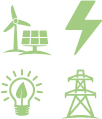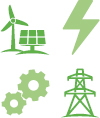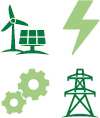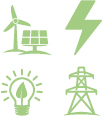Summary
The world has begun a transformation of its energy system from one dominated by fossil fuel combustion to one with net-zero emissions1 of carbon dioxide (CO2), the primary anthropogenic greenhouse gas (GHG). This decarbonization is the result of ongoing revolutions in energy technology, public policy, changing economics of energy options, and growing preferences for renewable and zero-carbon supply. In the United States, the energy transformation will require not only a shift from fossil fuel-based to low-carbon sources of energy but also an equally fundamental economic and social transition to strengthen the economy, promote equity and inclusion, and support communities, businesses, and workers.
Examples of the ongoing revolutions in energy technologies are widespread. Low-cost and reliable clean electricity can now become the cornerstone of a net-zero emissions economy, as fuel for electric vehicles, efficient heat pumps, and a source of heat and clean hydrogen for industrial processes. The past decade has seen the levelized cost of wind and solar power drop nearly 70 percent and 90 percent, respectively, while the cost of lithium-ion batteries for electric vehicles dropped by 85 percent. Although the variability of wind and solar makes it impossible to maintain a reliable electricity system with these sources alone, hydropower, energy storage, bioenergy, nuclear energy, geothermal energy, and natural gas with carbon capture and sequestration are available for building a reliable system.
Most near-term emissions reductions during a transition to net zero would come from the electricity sector and the electrification of light- and medium-duty vehicles and home heating. Light-duty transportation and home heating are ready to deliver significant emissions reductions because low-cost, reliable, and clean electricity can be used as fuel for electric vehicles and efficient heat pumps. Substantial improvements in energy efficiency are achievable across all sectors, from buildings to transportation and industry, and can help to meet future demands for energy services cost-effectively. Although technology exists to decarbonize all parts of the energy system, some sectors remain at precommercial or first-of-a-kind demonstration stages and will require significant improvement in cost and performance to become commercially viable. These include aviation, shipping, and industrial subsectors such as steel, cement, and chemicals manufacturing. If innovation fails to provide cost-effective
___________________
1 Net-zero emissions are achieved when any CO2 or other GHG emitted is offset by an equivalent amount of CO2 removal and sequestration.
alternatives to some of the difficult-to-decarbonize components in time, negative emissions technologies such as direct air capture and storage (DACS), bioenergy with carbon capture and sequestration (BECCS), and enhanced carbon uptake in soils and forests also offer additional options to offset residual emissions from activities that prove more costly to directly decarbonize. The nation has this decade to proactively invest in maturing and improving this suite of solutions and to ensure that as many as possible are prepared for widespread use in the 2030s and 2040s.
This energy transformation is central to mitigating climate change. A transition to net-zero emission in the U.S. economy would directly reduce global CO2 and other GHG emissions by approximately 10 percent. The country’s leadership and innovation capabilities can have an even greater global impact by helping build a suite of affordable clean energy and climate mitigation solutions for export and use around the world. A transition to net zero in the United States would nearly eliminate adverse health impacts of fossil fuel use, which may be responsible for half a million premature deaths or more over the next decade—public health impacts that fall disproportionately on low-income communities and communities of color. Recent polling indicates that a clear majority of Americans now support action to control the country’s anthropogenic GHG emissions, as do large majorities of citizens in most other countries.
Given these opportunities, a large and growing number of countries, states, cities, and corporations have pledged to reduce their net GHG emissions to zero over the next 30 years. Although some groups call for a shorter or longer transition period, most target net-zero emissions by 2050 because if this goal is adopted globally, future warming would be limited to a target of 1.5 degrees Celsius. A quicker transition would require expensive replacement of long-lived capital assets before the end of their useful lives. Most proposals call for net-zero emissions with carbon sinks rather than zero emissions because some emissions sources are likely to be too difficult or expensive to mitigate with current and projected technology.
To help policy makers, businesses, communities, and the public better understand what net zero would mean for the United States, the National Academies of Sciences, Engineering, and Medicine convened a committee of experts to investigate how the United States could best decarbonize its energy system. This committee’s statement of task (shown in Chapter 1, Box 1.2) called for the committee to “assess the technological, policy, social, and behavioral dimensions to accelerate the decarbonization of the U.S. economy” and “focus its findings and recommendations on near- and midterm (5–20 years) high-value policy improvements and research investments.” The statement of task calls for interim and final reports. This interim report focuses on the electricity, transportation, industrial, and buildings sectors, which comprise most of the
energy system, and CO2 emissions, the GHG with the greatest climate impact. In what follows, “energy system” is used as a shorthand for the union of the electricity, transportation, industrial, and buildings sectors. The committee understands that reaching net zero will require addressing all emissions sectors and GHGs. Its final report will include agriculture emissions, expanded treatment of technologies (e.g., hydrogen, low-carbon fuels, and negative emissions technologies), and policy actors (state, local, private sector, and nongovernmental organizations). It will also consider discussion of wider societal trends, such as changes in economics, demographics, housing patterns, and infectious disease incidents that impact the energy system.
This interim report of the committee provides a technical blueprint and policy manual for the first critical 10 years of a 30-year effort to transform the U.S. energy system to net-zero GHG emissions. It focuses on “no-regrets” actions—essential near-term policies that are valuable under any feasible pathway to a net-zero emissions energy system—and the need for some hedging actions during these first 10 years to maintain optionality in the face of substantial uncertainty. For example, renewable sources of electricity will inevitably play a major role given their current low cost, but there are multiple candidates for zero-carbon firm sources of electricity needed because renewable supplies are intermittent. This implies the need for robust research, development, and demonstration (RD&D) across the range of possible candidates, and infrastructure that is specifically planned to be robust to uncertainty in the final mix deployed. It should also be noted that the committee was specifically not tasked to determine whether the nation should pursue deep decarbonization, but rather to evaluate options for decarbonization and the highest-priority actions to pursue, given that goal.
Net-zero policy is about more than non-emitting energy technologies, because a host of other issues that people care deeply about are also strongly impacted by the ways the U.S. economy produces and consumes energy. The transition represents an opportunity to build a more competitive U.S. economy, increase the availability of high-quality jobs, build an energy system without the social injustices that permeate our current system, and allow those individuals, communities, and businesses that are marginalized today to share equitably in future benefits. Maintaining public support through a three-decade transition to net zero simply cannot be achieved without the development and maintenance of a strong social contract. This is true for all policy proposals described here, including a carbon tax, clean energy standards, and the push to electrify and increase efficiencies in end uses such as vehicle and building energy use. The United States will need specific policies to engage and cultivate public support for the transition, ensure an equitable and just net-zero energy system, and facilitate the recovery of people and communities hurt by the transition.
GOALS AND POLICIES
The committee agreed on the following five technological goals and four socioeconomic goals for net-zero policy during the 2020s:
Technological Goals
- Invest in energy efficiency and productivity.
- Electrify energy services in transportation, buildings, and industry.
- Produce carbon-free electricity.
- Plan, permit, and build critical infrastructure.
- Expand the innovation toolkit.
Socioeconomic Goals
- Strengthen the U.S. economy.
- Promote equity and inclusion.
- Support communities, businesses, and workers.
- Maximize cost-effectiveness.
Each of these goals is discussed below, with some quantitative targets added. Table S.1 at the end of this summary provides the committee’s list of highest-priority federal policies for the next 10 years to put the United States on a net-zero path. The table itemizes the policies or groups of policies that together steer the nation’s equitable energy transition toward a net-zero economy. Column 1 lists these policies, which are further summarized in the table’s notes, in the discussion at the end of this summary, and in Chapter 4. Every policy receives a score for each of the technological goals (shown in column 2, and described in Chapter 2) and socioeconomic goals (shown in column 3, and described in Chapter 3). These scores represent the consensus judgment of the committee’s members. Column 4 identifies the branch of the federal government that would be responsible for the policy, and column 5 specifies the required congressional appropriation, if any. The technological and socioeconomic goals are represented by icons (defined below). Icon shade indicates how important each policy is to achieving the goal: darkest shade indicates highest priority—that the policy is indispensable to achieve the objective; medium shade means that the policy is important to achieve the objective; and lightest shade indicates a supporting role. Absence of an icon indicates that the policy would have a small positive role in achieving the objective (and might in some cases have a small negative impact).
The committee’s work has been informed by many analyses that examine the implications for costs of various technologies and policies between now and 2050. The committee recognizes the inherent uncertainties that underpin modeling exercises that attempt to capture conditions over the next 3 decades. Thinking back over the
past 3 decades, it would have been hard to imagine the energy system implications of the many social and technological changes that have occurred since 1990. Even the best modeling analyses do not capture the expected and unexpected consequences of structural changes over the next 3 decades in electricity demand, in technology change, in fundamental economic trends, in social values and consumer behavior, and in untold other influences.
With an appropriate degree of humility regarding the influence of as yet unknown changes in consumer behavior, technologies, and other transformational changes, the committee has focused this interim report on no-regrets actions that will position the United States on a path toward a net-zero economy. The committee provides numerous instances where it has quantified the types of actions that need to occur in government policies, federal funding, markets, and behaviors to meet the objective of an economy with net-zero emissions by midcentury. These numbers reflect a combination of measures that could meet the net-zero emissions objective with trade-offs across diverse socioeconomic and technical goals. While the committee recognizes that other pathways could accomplish the same objective, it has tried in this interim report to be clear about how those trade-offs have been balanced.
Technological Goals
As reviewed in Chapter 2, recent techno-economic analyses of the net-zero transition in the United States identify five near-term actions in virtually every study that are critical in the 2020s while not locking in a technological mix that might change because of technological advances or breakthroughs. At the same time, a 30-year transition would require that some significant parts of the transition be completed early, either as critical foundations to facilitate other actions, or because expensive pieces of long-lived emitting capital stock reach the end of their useful lives in the 2020s and need to be replaced with a non-emitting alternative (e.g., a gas furnace replaced by an electric heat pump) to avoid lock-in.
The critical near-term actions to accomplish the five technological goals are listed below, next to the icon that identifies the goal in Table S.1.
![]() Invest in energy efficiency and productivity. Over the next 10 years, energy used for space conditioning and plug loads would be reduced in existing buildings by 3 percent per year and total energy use by new buildings reduced by 50 percent. The rate of increase of industrial energy productivity (dollars of economic output per unit of energy consumed) would be increased from a recent pace of 1 percent per year to 3 percent per year. Note that energy efficiency in transportation, buildings, and industry overlaps with electrification, because switching to electric heat pumps and
Invest in energy efficiency and productivity. Over the next 10 years, energy used for space conditioning and plug loads would be reduced in existing buildings by 3 percent per year and total energy use by new buildings reduced by 50 percent. The rate of increase of industrial energy productivity (dollars of economic output per unit of energy consumed) would be increased from a recent pace of 1 percent per year to 3 percent per year. Note that energy efficiency in transportation, buildings, and industry overlaps with electrification, because switching to electric heat pumps and
motors also significantly increases the efficiency of heating and transportation relative to fossil-fueled boilers and internal combustion engines. Further, electrification provides opportunities to install broadband and smart grid technologies that enable demand-side management and grid optimization. Also, improvements in efficiency and productivity help to reduce the power loads for equipment, which can reduce the cost of capital and operations lowering hurdles for electrification in these sectors.
![]() Electrify energy services in transportation, buildings, and industry. The most significant actions to accomplish this goal are as follows: reach zero-emissions vehicles as approximately 50 percent of new vehicle sales across all classes by 2030 (light, medium, and heavy); increase the share of electric heat pumps for heating and hot water to 25 percent of residential and 15 percent of commercial buildings, replacing fossil furnaces and boilers; initiate policies for new construction to be all electric in all practical climate zones; and transition low- to moderate-temperature process heat sources to low-carbon electrical power (e.g., by replacing or supplementing conventional units with electric boilers, heat pumps, or noncontact thermal sources such as infrared or microwave) totaling approximately 10 GW of capacity.
Electrify energy services in transportation, buildings, and industry. The most significant actions to accomplish this goal are as follows: reach zero-emissions vehicles as approximately 50 percent of new vehicle sales across all classes by 2030 (light, medium, and heavy); increase the share of electric heat pumps for heating and hot water to 25 percent of residential and 15 percent of commercial buildings, replacing fossil furnaces and boilers; initiate policies for new construction to be all electric in all practical climate zones; and transition low- to moderate-temperature process heat sources to low-carbon electrical power (e.g., by replacing or supplementing conventional units with electric boilers, heat pumps, or noncontact thermal sources such as infrared or microwave) totaling approximately 10 GW of capacity.
![]() Produce carbon-free electricity. During the 2020s, the nation would need to roughly double the share of electricity generated by non-carbon-emitting sources to roughly 75 percent by 2030. Until 2025, this would require an average pace of wind and solar installation that each year matches or exceeds the record historical yearly deployment of these technologies and accelerates to an even faster pace from 2025 to 2030. Emitting coal plants would continue to retire at the current or an accelerated pace. Existing nuclear plants would be preserved wherever it is possible to continue safe operations. Emitting gas-fired generation would decline 10 to 30 percent by 2030 and total capacity would be roughly flat. Some new gas-fired capacity in certain regions could be built during the 2020s to replace aging assets, including coal, because it is more economical than coal regardless of age and can be used to replace aging assets and where coal retirements require replacement capacity for reliability purposes, and where new gas capacity is prepared to retire by 2050 or retrofit to com-bust hydrogen or be equipped with carbon capture.
Produce carbon-free electricity. During the 2020s, the nation would need to roughly double the share of electricity generated by non-carbon-emitting sources to roughly 75 percent by 2030. Until 2025, this would require an average pace of wind and solar installation that each year matches or exceeds the record historical yearly deployment of these technologies and accelerates to an even faster pace from 2025 to 2030. Emitting coal plants would continue to retire at the current or an accelerated pace. Existing nuclear plants would be preserved wherever it is possible to continue safe operations. Emitting gas-fired generation would decline 10 to 30 percent by 2030 and total capacity would be roughly flat. Some new gas-fired capacity in certain regions could be built during the 2020s to replace aging assets, including coal, because it is more economical than coal regardless of age and can be used to replace aging assets and where coal retirements require replacement capacity for reliability purposes, and where new gas capacity is prepared to retire by 2050 or retrofit to com-bust hydrogen or be equipped with carbon capture.
![]() Plan, permit, and build critical infrastructure. Build or upgrade electrical transmission facilities to increase overall transmission capacity (as measured in GW-miles) by as much as 60 percent by 2030 to interconnect and harness low-cost wind and solar power across the country. Accelerate the build-out of the nation’s electric vehicle (EV) recharging network, including at least 3 million Level 2 chargers and 120,000 DC fast chargers by 2030. This infrastructure should be a mix of private and public ownership and operation, including fleet operators. Plan and initiate a national CO2 transport and storage network to ensure that CO2 can be captured at point
Plan, permit, and build critical infrastructure. Build or upgrade electrical transmission facilities to increase overall transmission capacity (as measured in GW-miles) by as much as 60 percent by 2030 to interconnect and harness low-cost wind and solar power across the country. Accelerate the build-out of the nation’s electric vehicle (EV) recharging network, including at least 3 million Level 2 chargers and 120,000 DC fast chargers by 2030. This infrastructure should be a mix of private and public ownership and operation, including fleet operators. Plan and initiate a national CO2 transport and storage network to ensure that CO2 can be captured at point
sources across the country, including in industry, power generation, and low-carbon fuels production (including hydrogen).
![]() Expand the innovation toolkit. The committee proposes a tripling of federal investment in clean energy RD&D to provide new technological options, to reduce costs of existing options, and to better understand how to manage a socially just energy transition. Innovations that would fundamentally enhance the net-zero transition include next-generation energy systems for transportation, buildings, and industry; improved energy storage and firm low-carbon electricity generation options to complement variable renewable electricity; low-cost zero-carbon fuels including hydrogen from the electrolysis of water or biomass gasification; lower-cost carbon capture and use technologies; and lower-cost direct air capture. Progress is needed in particular on net-zero options for aviation, marine transport, and the production of steel, cement, and bulk chemicals. As important will be innovations in how federal policies and programs support RD&D, particularly for technologies in the demonstration and deployment stages.
Expand the innovation toolkit. The committee proposes a tripling of federal investment in clean energy RD&D to provide new technological options, to reduce costs of existing options, and to better understand how to manage a socially just energy transition. Innovations that would fundamentally enhance the net-zero transition include next-generation energy systems for transportation, buildings, and industry; improved energy storage and firm low-carbon electricity generation options to complement variable renewable electricity; low-cost zero-carbon fuels including hydrogen from the electrolysis of water or biomass gasification; lower-cost carbon capture and use technologies; and lower-cost direct air capture. Progress is needed in particular on net-zero options for aviation, marine transport, and the production of steel, cement, and bulk chemicals. As important will be innovations in how federal policies and programs support RD&D, particularly for technologies in the demonstration and deployment stages.
Please note that some regulatory reform will be necessary to achieve many of the above technological goals. In particular, timely siting and permitting of the new electricity transmission infrastructure is likely to prove difficult or impossible without regulatory reform. Also, the above goals reflect the committee’s judgment that a net-zero energy system able to meet the nation’s projected business-as-usual demand for energy services will be much easier to achieve than one requiring dramatic reductions in demand for energy services. Thus, the goals do not include greatly reduced mobility or home size.
Socioeconomic goals
A complete transformation of the energy system would affect most aspects of life in this country, with impacts far beyond the installation of new technologies. The U.S. energy system does not currently serve all Americans well. Historically marginalized and low-income populations have energy bills that they struggle to pay and lack the capital to reap benefits from higher-efficiency technologies. They also suffer disproportionate exposure to health and environmental hazards from power generation and climate change with diminished ability to eliminate or mitigate that exposure, have comparatively little say in decision making about siting of energy infrastructure, and receive a disproportionately small share of financial and other benefits from the energy system.
The United States has long been the world’s leading technological innovator, but has not effectively used this advantage to sustain domestic manufacturing that could
supply domestic and international markets with low- and zero-carbon energy technologies. The decline of the manufacturing sector has cost the economy high-quality jobs, increased income inequality, and contributed to public dissatisfaction.
One cause for optimism is that the country is the best-resourced nation in the world for a transition to net zero. The United States has abundant solar and wind resources both onshore and offshore. Additionally, 40 million acres already are devoted to producing biofuels. The country has plentiful and economically accessible natural gas and enormous geologic and terrestrial reservoirs for CO2 sequestration.
A transformation to a net-zero economy could combine these natural assets with the nation’s culture of innovation to produce an energy system that ameliorates ongoing social injustices in today’s energy system and fairly distributes both opportunities and costs. Studies estimate that the transition could increase net employment in the energy system by roughly 1 million to 2 million jobs domestically over the next decade, although the impacts on the location and other characteristics of employment are complex. The innovation and capital expenditures required for a successful transition could revitalize the U.S. manufacturing and commercialization sectors. But the United States will achieve these benefits only if it has the appropriate policies in place. Otherwise, the transition might exacerbate inequity, concentrate opportunity in the hands of a few, accelerate the offshoring of manufacturing, and fail to mitigate job losses in industries and regions that are left behind.
Chapter 3 describes the four critical socioeconomic goals that net-zero policies should be designed to advance. They are as follows:
![]() Strengthen the U.S. economy. The transition to net zero provides an opportunity to revitalize U.S. manufacturing, construction, and commercialization sectors in clean energy and energy efficiency, while providing a net increase in jobs paying higher wages than the national average. The transition would enhance U.S. leadership in clean energy and climate mitigation solutions for which global demand will reach trillions of dollars over coming decades. The net-zero policy portfolio should be designed to strengthen the U.S. economy, with comprehensive policies that enhance the manufacturing sector and promote the innovations needed during the transition.
Strengthen the U.S. economy. The transition to net zero provides an opportunity to revitalize U.S. manufacturing, construction, and commercialization sectors in clean energy and energy efficiency, while providing a net increase in jobs paying higher wages than the national average. The transition would enhance U.S. leadership in clean energy and climate mitigation solutions for which global demand will reach trillions of dollars over coming decades. The net-zero policy portfolio should be designed to strengthen the U.S. economy, with comprehensive policies that enhance the manufacturing sector and promote the innovations needed during the transition.
![]() Promote equity and inclusion. Policies should promote equitable access to the benefits of net-zero energy systems, including reliable and affordable energy, opportunities to benefit from the best available technology, new employment opportunities, and opportunities for financial returns and wealth creation. Net-zero policy should work to eliminate inequities in the current energy system that disadvantage historically marginalized and low-income populations. Net-zero policy must include regular opportunities for, and responses to, community input, as well as ensure
Promote equity and inclusion. Policies should promote equitable access to the benefits of net-zero energy systems, including reliable and affordable energy, opportunities to benefit from the best available technology, new employment opportunities, and opportunities for financial returns and wealth creation. Net-zero policy should work to eliminate inequities in the current energy system that disadvantage historically marginalized and low-income populations. Net-zero policy must include regular opportunities for, and responses to, community input, as well as ensure
fair access to benefits and fair sharing of costs, for the pragmatic reason that public support must be maintained for decades to complete a successful net-zero transition.
![]() Support communities, businesses, and workers. Any fundamental technological and economic transition creates new opportunities as well as job losses in legacy industries and other associated impacts. In particular, the loss of a critical employer could devastate jobs, tax revenues, and other economic impacts in a community or even in whole regions, unless new opportunities can be attracted to replace it with low-carbon competitive employment in a timely manner. Policies should promote fair access to new long-term employment opportunities, provide financial and other support to communities that might otherwise be harmed by the transition, and ensure that jobs created through the transition are high quality, providing at a minimum a safe and secure working environment, family-sustaining wages and comprehensive benefits, regular schedules and hours, and opportunities for skills development.
Support communities, businesses, and workers. Any fundamental technological and economic transition creates new opportunities as well as job losses in legacy industries and other associated impacts. In particular, the loss of a critical employer could devastate jobs, tax revenues, and other economic impacts in a community or even in whole regions, unless new opportunities can be attracted to replace it with low-carbon competitive employment in a timely manner. Policies should promote fair access to new long-term employment opportunities, provide financial and other support to communities that might otherwise be harmed by the transition, and ensure that jobs created through the transition are high quality, providing at a minimum a safe and secure working environment, family-sustaining wages and comprehensive benefits, regular schedules and hours, and opportunities for skills development.
![]() Maximize cost-effectiveness. This goal begins with an objective to be accomplished—in this case, achieving a net-zero economy by 2050—and finding the least-cost (or most cost-effective) path to accomplish it. Here, the cost of a particular policy is the material consumption that households must give up, including any changes in taxes or government services, to achieve net-zero emissions. A policy’s cost-effectiveness measures how this cost compares to the least-cost alternative that achieves the same net-zero outcome and associated benefits. Cost-effectiveness is important because society has multiple objectives, including material well-being. If the country can avoid spending more than necessary in order to achieve net-zero emissions, additional resources are available for other aspirations. However, cost-effectiveness analysis ignores how costs and benefits are distributed within an economy. A U.S. net-zero policy will necessarily need to balance cost-effectiveness with equity and other goals.
Maximize cost-effectiveness. This goal begins with an objective to be accomplished—in this case, achieving a net-zero economy by 2050—and finding the least-cost (or most cost-effective) path to accomplish it. Here, the cost of a particular policy is the material consumption that households must give up, including any changes in taxes or government services, to achieve net-zero emissions. A policy’s cost-effectiveness measures how this cost compares to the least-cost alternative that achieves the same net-zero outcome and associated benefits. Cost-effectiveness is important because society has multiple objectives, including material well-being. If the country can avoid spending more than necessary in order to achieve net-zero emissions, additional resources are available for other aspirations. However, cost-effectiveness analysis ignores how costs and benefits are distributed within an economy. A U.S. net-zero policy will necessarily need to balance cost-effectiveness with equity and other goals.
System-Wide Policies
Many of the policies listed in Table S.1 would affect the nation’s economic and social systems as a whole, given the pervasive (but often invisible) role of carbon in so many elements of Americans’ day-to-day experience. The committee’s set of recommended policies include some that address these system-wide impacts, facilitate the net-zero transition as a whole, and help advance most of the technological and social-economic goals.
The policy for a U.S. emissions budget covers CO2 and other GHG emissions and calls for a target of net zero in 2050 along with regular review of emissions progress and the tracking of specified milestones for technological and social goals. The committee considers
a quantitative budget and regular review to be essential for the nation to keep up with the challenging pace required for the net-zero transition, to point out the need to augment policies where progress lags, and to save money where new innovation obviates the need for continuing standards or incentives or costly solutions in markets.
The committee proposes an economy-wide price on carbon beginning at $40/t CO2 and rising by 5 percent per year. The advantages of an economy-wide price on carbon are that it would unlock innovation in every corner of the energy economy, send appropriate signals to myriad public and private decision makers, and encourage a cost-effective route to net zero. However, assuming that the country implements a carbon price before key trade competitors, a mechanism that levels the playing field for domestic firms and avoids emissions leakage will be necessary. Also, because the direct impacts of an economy-wide price on carbon would fall disproportionately on people with the lowest incomes and the fewest choices, it should be augmented by rebates and by funding programs that promote a fair and just transition. The proposed carbon price is deliberately set at a level that would not by itself cause a 30-year transition to net zero because of concerns about equity, fairness, and competitiveness. For example, the committee was not confident that it could design a package of policies that would address competitiveness and mitigate unfair impacts of a carbon price that starts at or climbs rapidly to $100/tCO2.
In addition, the committee calls for the establishment of entities within the federal government to bring equitable access to economic opportunities and wealth creation during the energy transition. These policies are designed to help achieve diversity and fairness goals and to support workers, families, and communities through the transition. The recommendations include the establishment of a 2-year federal National Transition Task Force to evaluate the long-term implications of the transition for communities, workers, and families and identify strategies for ensuring a just transition, and a White House-level Office of Equitable Energy Transitions to act on the recommendations of the task force, establish just transition targets, and track progress in achieving them by federal programs. The primary policy to help communities achieve new opportunities or mitigate impending damages is the establishment of a new independent National Transition Corporation. The committee debated many alternative mechanisms and chose this option because an independent corporation could take the steady long view required to guide the transition initiatives to success.
Private sources of capital are unlikely to be sufficient to finance the low-carbon economic transition, especially during the 2020s when the effort is new. In order to ensure that capital is available for this transition, the committee calls for the establishment of a Green Bank to mobilize finance, initially capitalized at $30 billion. Partial financing by a Green Bank would reduce risk for private investors and encourage rapid
expansion of private sources capital. To better align the economy with the risks and benefits of transition policies and climate change, the committee includes a policy to require annual Securities and Exchange Commission (SEC) reporting of these risks and benefits by private companies and their inclusion in stress tests by the Federal Reserve and in all cost-benefit analyses by federal agencies.
The committee recommends a comprehensive education and training initiative to provide the workforce required for the transition; to improve the competitiveness of the country’s building, manufacturing, and energy sectors; and to fuel future innovation. Education and training are also critical to meet societal objectives by providing fair access to new high-quality jobs.
The committee recommends a number of policies to directly enhance and expand the energy innovation toolkit—most notably by the proposed tripling of the Department of Energy’s (DOE’s) funding in low- or zero-carbon RD&D over the next 10 years by Congress, including increasing the agency’s funding of large-scale demonstration projects, and the support for social science research on the social and economic aspects of advancing the transition and ensuring that it is just. Chapters 2 and 3 identify specific research needs, while Chapter 4 includes recommendations that propose an allocation of RD&D funding among agencies and among research and demonstration topics.
Past policy measures accelerated RD&D in wind and solar electricity, while financial incentives created niche markets by allowing still-expensive wind and solar to compete with fossil and other sources. The ongoing competition continuously reduced costs of renewables over time by orders of magnitude and returned many times the federal investment to the U.S. economy. The same can be said of the tax credits, other incentives and other federal RD&D support for the development of unconventional natural gas, LED lights, and many other energy innovations. By offering federal support for net-zero RD&D and early market deployment, the policies proposed in Table S.1 will unleash innovation from many sources, from universities and federal labs, to companies competing to capture emerging markets, and to a parallel search by thousands of communities for the best routes to a just and beneficial transition.
Policies Targeting Specific Economic Sectors or Goals
The proposed carbon price would not be large enough during the 2020s to incentivize the deployment of some non-emitting technologies that have relatively high marginal cost and yet must be deployed early, either because long-lived capital stock needs replacement (i.e., a cement plant) or because delay would make the eventual rate of transition infeasible or more expensive. Thus, the committee developed some of its policies in Table S.1 to target specific energy supply and distribution goals.
The committee proposes, for example, a clean energy standard for electricity to ensure that the power sector relies increasingly on non-emitting electricity. It also proposes needed policy reforms governing clean electricity markets, amendments to the Federal Power Act to allow timely siting and permitting of new long-distance transmission, and a program to plan, permit, and install the needed new electric transmission capacity. Last, it proposes accelerated installation of smart electricity meters and an expansion of broadband in rural and low-income households. This will allow the electric system to depend upon expanded flexible demand that is enabled by pricing reforms and metering and information-infrastructure upgrades.
Under the committee’s recommendations, electrification of the transportation sector and buildings would primarily be accomplished by manufacturing and performance standards for electric vehicles and building equipment. For transportation, these would specify fleetwide emissions standards for new vehicle sales that drop to zero in time for the on-road fleet to meet net-zero goals in 2050, appliance standards for the electrification of building heating and cooling, and policies for accelerating the development of electric vehicle charging infrastructure.
To increase the energy efficiency of buildings during the 2020s, the committee calls for weatherization, retrofits, and other support for low-income households, which would also further diversity and fairness goals, as well as emissions caps and efficiency standards for all federal buildings. Note that whole-building energy efficiency can be improved in a multitude of ways, all of which would be simultaneously nudged by the economy-wide price on carbon.
Last, Table S.1 contains the committee’s recommendations for policies that directly or indirectly advance a comprehensive clean-energy industrial policy. These include the following policies:
- Output-based allocations and carbon border adjustments that would accompany the carbon price in order to maintain industrial competitiveness;
- A Green Bank to help finance an expansion of clean industry and clean technology manufacturing;
- Corporate climate risk disclosure rules;
- Wholesale power market reforms;
- Education and training policies for the new energy economy;
- Expanded RD&D;
- Electrification of tribal lands;
- A package of loan guarantees and sunsetting subsidies to support installation of non-emitting industrial equipment (e.g., electric boilers) and expand cleantech manufacturing;
- A process for planning and initiating a national network to transport and safely store CO2 captured by industrial sources and perhaps by fossil electricity plants with carbon capture; and
- Procurement and other standards for companies that receive federal funds, including labor standards and Buy America/American policies.
COST ESTIMATES AND CAPITAL REQUIREMENTS
This interim report contains three kinds of estimates: the net present value of the aggregate transition costs, the sum of capital required to build all the new hardware and controls in each sector, and the needed congressional appropriations. It also quotes current costs (i.e., levelized cost of energy) of alternative new resources additions. It is important to note that only the net present value of aggregate transition costs represents a true cost to the United States. Capital requirements and congressional appropriations can be considered investments in the country’s economy that provide long-term returns to private and public sectors. Of course, all of these estimates are highly uncertain. Additionally, any direct costs are balanced against significant public and private benefits of a net-zero transition. These include the substantial avoided health impacts from air pollution within the United States, new economic and employment opportunities, significant downward pressure on global oil prices, and, if other countries also meet similar emissions reductions goals, the avoidance of a substantial portion of planet-altering climate change-related damages to the country that are not already inevitable even with a transition to net zero by midcentury. These could be in the hundreds of billions of dollars annually if estimated health benefits come to fruition and offset some, all, or more than the cost of the transition.
Chapter 2 concludes that the estimated fraction of gross domestic product that the nation would likely spend on energy in a net-zero economy would be smaller than the fraction that the nation has spent on energy in the past, including the past decade (see Chapter 2, Figure 2.3). Studies reviewed in Chapter 2 also estimate total cumulative incremental energy expenditures that average approximately $300 billion through 2030—a roughly 3 percent increase relative to a business-as-usual baseline of approximately $9.4 trillion (net present values of cumulative total expenditures with a 2 percent real social discount rate). It is important to note that these cost estimates do not capture general equilibrium effects, such as changes in global oil prices. Nor do these cost estimates include impacts of changes in the country’s balance of trade, which include both positive and negative factors. Last, several of the policies in Table S.1 are designed to reduce or eliminate adverse impacts of costs on trade-impacted firms and low-income households.
TABLE S.1 Summary of Policies Designed to Meet Net-Zero Carbon Emissions Goal and How the Policies Support the Technical and Societal Objectives
| Policy | Technological Goals | Socioeconomic Goals | Government Entities | Appropriation, if Any | Notes |
|---|---|---|---|---|---|
| Establish U.S. commitment to a rapid, just, equitable transition to a net-zero carbon economy. | |||||
| U.S. CO2 and other GHG emissions budget reaching net zero by 2050. |
|
|
Executive and Congress | $5 million per year. | Budget is central for imposing emissions discipline, although any consequences for missing the target must be implemented through other policies. Funds are primarily for administration of the budget and data collection and management. |
| Economy-wide price on carbon. |
|
|
Congress | None. Revenue of $40/tCO2 rising 5% per year, which totals approximately $2 trillion from 2020 to 2030. | Carbon price level not designed to directly achieve net-zero emissions. Additional programs will be necessary to protect the competitiveness of import/export exposed businesses. |
| Establish 2-year federal National Transition Task Force to assess vulnerability of labor sectors and communities to the transition of the U.S. economy to carbon neutrality. |
|
|
Congress | $5 million per year. | Task force responsible for design of an ongoing triennial national assessment on transition impacts and opportunities to be conducted by the Office of Equitable Energy Transitions. |
Establish White House Office of Equitable Energy Transitions.
|
|
|
Congressional appropriation | $25 million per year, rising to $100 million per year starting in 2025. | Federal office establishes targets and monitors and advances progress of federal programs aimed at a just transition. |
| Establish an independent National Transition Corporation to ensure coordination and funding in the areas of job losses, critical location infrastructure, and equitable access to economic opportunities and wealth, and to create public energy equity indicators. |
|
|
Congressional appropriation | $20 billion in funding over 10 years. | Primary means to mediate harms that occur during transition, including support for communities that lose a critical employer, support for displaced workers, abandoned site remediation, and opportunities for communities to invest in a wide range of clean energy projects. |
| Policy | Technological Goals | Socioeconomic Goals | Government Entities | Appropriation, if Any | Notes |
|---|---|---|---|---|---|
| Set rules/standards to accelerate the formation of markets for clean energy that work for all. | |||||
| Set clean energy standard for electricity generation, designed to reach 75% zero-emissions electricity by 2030 and decline in emissions intensity to net-zero emissions by 2050. |
|
|
Congress | None. | |
| Set national standards for light-, medium-, and heavy-duty zero-emissions vehicles, and extend and strengthen stringency of Corporate Average Fuel Economy (CAFE) standards. Light-duty zero-emission vehicle (ZEV) standard ramps to 50% of sales in 2030; medium- and heavy-duty to 30% of sales in 2030. |
|
|
Congress | None. | |
| Set manufacturing standards for zero-emissions appliances, including hot water, cooking, and space heating. Department of Energy (DOE) continues to establish appliance minimum efficiency standards. Standard ramps down to achieve close to 100% all-electric in 2050. |
|
|
Congress | None. | |
| Enact three near-term actions on new and existing building energy efficiency, two by DOE/Environmental Protection Agency (EPA)a and one by the General Services Administration (GSA). |
|
|
DOE, GSA | None. | GSA to set a cap on existing and new federal buildings that declines by 3% per year. |
| Enact five federal actions to advance clean electricity markets, and to improve their regulation, design, and functioning.b |
|
|
Congress | $8 million per year for Federal Energy Regulatory Commission (FERC) Office of Public Participation and Consumer Advocacy. | Two of these actions involve FERC utilizing existing authorities and three involve congressional actions, two directed to FERC and one to DOE. |
| Deploy advanced electricity meters for the retail market, and support the ability of state regulators to review proposals for time/location-varying retail electricity prices. |
|
|
Congressional appropriation for DOE | $4 billion over 10 years. |
| Policy | Technological Goals | Socioeconomic Goals | Government Entities | Appropriation, if Any | Notes |
|---|---|---|---|---|---|
| Recipients of federal funds and their contractors must meet labor standards, including Davis-Bacon Act prevailing wage requirements; sign Project Labor Agreements (PLAs) where relevant; and negotiate Community Benefits (or Workforce) Agreements (CBAs) where relevant. |
|
Congress | None. | ||
| Report and assess financial and other risks associated with the net-zero transition and climate change by private companies, government agencies, and the Federal Reserve. Private companies receiving federal funds must also report their clean energy research and development (R&D) by category (wind, solar, etc.). |
|
|
Congress | None. | Risk disclosures to be included in annual Securities and Exchange Commission (SEC) reports for private companies. Federal Reserve to use climate-related risks in financial stress tests. Federal agencies to include climate-related risks in all benefit cost analyses. All banks to report on comparative financial investments in all energy sources. |
| Ensure that Buy America and Buy American provisions are applied and enforced for key materials and products in federally funded projects. |
|
Congress | None. |
| Establish an environmental product declaration library to create the accounting and reporting infrastructure to support the development of a comprehensive Buy Clean policy. |
|
|
Congressional appropriation for EPA and DOE | $5 million per year. | |
| Invest (research, technology, people, and infrastructure) in a U.S. net-zero carbon future. | |||||
| Establish a federal Green Bank to finance low- or zero-carbon technology, business creation, and infrastructure. |
|
|
Congressional authorization and appropriation | Capitalized with $30 billion, plus $3 billion per year until 2030. | Additional requirements include public reporting of both energy equity analyses of investment and leadership diversity of firms receiving funds. |
| Amend the Federal Power Act and Energy Policy Act by making changes to facilitate needed new transmission infrastructure.c |
|
|
Congress | None. | |
| Policy | Technological Goals | Socioeconomic Goals | Government Entities | Appropriation, if Any | Notes |
|---|---|---|---|---|---|
| Plan, fund, permit, and build additional electrical transmission, including long-distance high-voltage, direct current (HVDC). Require fair public participation measures to ensure meaningful community input.d |
|
|
Congressional authorization and appropriation for DOE and FERC | $25 million per year to DOE for planning; $50 million per year for DOE and FERC to facilitate use of existing rights-of-way; finance build through Green Bank; $10 million per year to DOE for distribution system innovations. | Funds provide support for technical assistance to states, communities, and tribes to enable meaningful participation in regional transmission planning and siting activities. Funds to distribution utilities to invest in automation and control technologies. |
| Expand electric vehicle (EV) charging network for interstate highway system.e |
|
|
Congressional directive to Federal Highway Administration (FHWA) and National Institute of Standards and Technology (NIST); congressional appropriations to DOE | $5 billion over 10 years to expand changing infrastructure. | FHWA to expand its “alternative fuels corridor” program. NIST to develop interoperability standards for level 2 and fast chargers. DOE to fund expansion of interstate charging to support long-distance travel and make investments for EV charging for low-income businesses and residential areas. |
| Expand broadband for rural and low-income customers to support advanced metering. |
|
|
Congress to authorize and fund rural electric cooperatives and private companies to offer broadband | $0.5 billion for rural electric cooperatives and $1.5 billion for private companies. | 10% of investment costs to expand capabilities of smart grid to underserved areas. Grants or loans to rural electric providers and investment tax incentives to companies, both focused on rural and low-income communities. |
| Plan and assess the requirements for national CO2 transport network, characterize geologic storage reservoirs, and establish permitting rules.f Require fair public participation measures to ensure meaningful community input. |
|
|
Congressional authorization and appropriation to multiple agencies | $50 million to Department of Transportation (DOT) with other agencies involved for 5-year planning plus $50 million for block grants for community and stakeholder engagement. $10 billion to $15 billion total during the 2020s to DOE, U.S. Geological Survey (USGS), and Department of the Interior (DOI) to characterize reservoirs. Extend 45Q and increase to $70/tCO2—$2 billion per year. | Modeling studies and other analysis indicate that significant amounts of negative emissions will be needed to meet net-zero emissions. The CO2 pipeline network is needed even with 100% non-fossil electric power to enable carbon capture at cement and other industrial facilities with direct process emissions of greenhouse gases and to enable capture of CO2 from biomass or via direct air capture for use in production of carbon-neutral liquid and gaseous fuels. |
| Policy | Technological Goals | Socioeconomic Goals | Government Entities | Appropriation, if Any | Notes |
|---|---|---|---|---|---|
| Establish educational and training programs to train the net-zero workforce, with reporting on diversity of participants and job placement success.g |
|
|
Congressional appropriations to Department of Education, DOE, and National Science Foundation (NSF) | $5 billion per year for GI Bill-like program. $100 million per year for new undergraduate programs. $50 million per year for use-inspired and $375 million per year for other doctoral and postdoctoral fellowships. Eliminate visa restrictions for net-zero students. $7 million over 2020–2025 for the Energy Jobs Strategy Council. | Fields covered include science, engineering, policy, and social sciences, for students researching and innovating in low-carbon technologies, sustainable design, and the energy transition. |
| Revitalize clean energy manufacturing.h |
|
|
Congressional appropriation and direction of Green Bank and U.S. Export-Import Bank | Manufacturing subsidies for low-carbon products starting at $1 billion per year and phased out over 10 years. No additional appropriation required for loans and loan guarantees from Green Bank and Export-Import Bank. | Export-Import Bank should make available at least $500 million per year in low-carbon product and cleantech export financing and eliminate support for fossil technology exports. |
| Increase clean energy and net-zero transition research, development, and demonstration (RD&D) that integrates equity indicators.i |
|
|
Congressional appropriation for and directions to DOE and NSF | DOE clean energy RD&D triples from $6.8 billion per year to $20 billion per year over 10 years. DOE funds studies of policy evaluation at $25 million per year and regional innovation hubs at $10 million per year; DOE- and NSF-funded studies of social dimensions of the transition should be supported by an appropriation of $25 million per year. | Establish criteria for receiving funds on equity analysis, appropriate community input, and leadership diversity of companies applying for public investments. DOE to report on equity impacts and diversity of entities receiving public funds. |
| Increase funds for low-income households for energy expenses, home electrification, and weatherization. |
|
|
Congressional appropriation | Increase Weatherization Assistance Program (WAP) funding to $1.2 billion per year from $305 million per year. Direct the Department of Health and Human Services (HHS) to increase state’s share of Low Income Home Energy Assistance Program (LIHEAP) funds for home electrification and efficiency. |
| Policy | Technological Goals | Socioeconomic Goals | Government Entities | Appropriation, if Any | Notes |
|---|---|---|---|---|---|
| Increase electrification of tribal lands |
|
Congressional appropriation to DOE and U.S. Department of Agriculture (USDA) | $20 million per year for assessment and planning through DOE Office of Indian Energy Policy (DOE-IE) and USDA Rural Utilities Service (USDA-RUS); expand DOE-IE to $200 million per year. | Increase direct financial assistance for the build-out of electricity infrastructure through DOE-IE grant programs. | |
| Assist families, businesses, communities, cities, and states in an equitable transition, ensuring that the disadvantaged and at-risk do not suffer disproportionate burdens. | |||||
| Please note that the primary policies targeting fairness, diversity, and inclusion during the transition are establishing the Office of Equitable Energy Transitions and the National Transition Corporation, which are the fourth and fifth policies in this table. | |||||
| Establish National Laboratory support to subnational entities for planning and implementation of net-zero transition. |
|
|
Congressional appropriation | Additional funding to national laboratories’ annual funding commencing at the level of $200 million per year, rising to $500 million per year by 2025, and $1 billion per year by 2030. | To establish a coordinated, multi-laboratory capability to provide energy modeling, data, and analytic and technical support to cities, states, and regions to complete a just, equitable, effective, and rapid transition to net zero. |
| Establish 10 regional centers to manage socioeconomic dimensions of the net-zero transition. j |
|
|
Congressional authorization and appropriations to DOE | $5 million per year for each center; $25 million per year for external research budget to provide data, models, and decision support to the region. | Coordinated by the Office of Equitable Energy Transitions. |
| Establish net-zero transition office in each state capital. |
|
|
Congressional appropriations | $1 million per year in matching funds for each state. | Coordinate state’s effort with federal and regional efforts. |
| Establish local community block grants for planning and to help identify especially at-risk communities. Greatly improve environmental justice (EJ) mapping and screening tool and reporting to guide investments. |
|
|
Congressional appropriations to DOE | $1 billion per year in grants administered by regional centers. | Required to qualify for funding from the National Transition Corporation. Block grant funding requires inclusive participation and engagement by historically marginalized and low-income groups. |
| KEY TO ICONS | |||||
| DARK GREEN icon indicates that the policy is highest priority and indispensable to achieve the objective. MEDIUM GREEN icon indicates that the policy is important to achieve the objective. LIGHT GREEN icon indicates that the policy would play a supporting role. No icon indicates that the policy would have at most a small positive role in achieving the objective (and might in, some cases, have a small negative impact on the objective). |
|||||
| Technological Goals | |||||
| Invest in energy efficiency and productivity. Examples include accelerating the rate of increase of industrial energy productivity (dollars of economic output per energy consumed) from the historic 1% per year to 3% per year. | |||||
 |
Electrify energy services in transportation, buildings, and industry. Examples include, by 2030, moving half of vehicle sales (all classes combined) to EVs, and deploying heat pumps in one-quarter of residences. | ||||
 |
Produce carbon-free electricity. Roughly double the share of electricity generated by carbon-free sources from 37% to 75%. | ||||
 |
Plan, permit, and build critical infrastructure. Build critical infrastructure needed for the transition to net zero, including new transmission lines, an EV charging station network, and a CO2 pipeline network. | ||||
| Expand the innovation toolkit. Triple federal support for net-zero RD&D. | |||||
| Socioeconomic Goals | |||||
| Strengthen the U.S. economy. Use the energy transition to accelerate U.S. innovation, reestablish U.S. manufacturing, increase the nation’s global economic competitiveness, and increase the availability of high-quality jobs. | |||||
| Promote equity and inclusion. Ensure equitable distribution of benefits, risks, and costs of the transition to net zero. Integrate historically marginalized groups into decision making by ensuring adherence to best-practice public participation laws. Require that entities receiving public funds report on leadership diversity to ensure nondiscrimination. | |||||
| Support communities, businesses, and workers. Ensure support for those directly and adversely affected by the transition. | |||||
| Maximize the cost-effectiveness of the transition to net zero. | |||||
a Direct DOE/EPA to expand outreach of and support for adoption of benchmarking and transparency standards by state and local government through the expansion of Portfolio Manager. Direct DOE/EPA to further investigate the development of model carbon-neutral standards for new and existing buildings that, in turn, could be adopted by states and local authorities. Policies targeting retrofits of existing buildings will be in the final report.
b FERC should work with regional transmission organizations (RTOs) and independent system operators (ISOs) to ensure that markets in all parts of the country are designed to accommodate the shift to 100% clean electricity on the relevant timetable. Congress should clarify that the Federal Power Act does not limit the ability of states to use policies (e.g., long-term contracting with zero-carbon resources procured through market-based mechanisms) to support entry of zero-carbon resources into electric utility portfolios and wholesale power markets. Congress should further direct FERC to exercise its rate-making authority over wholesale prices in ways that accommodate state action to shape the timing and character of the transitions in their electric resource mixes. Congress should reauthorize the FERC Office of Public Participation and Consumer Advocacy to provide grants and other assistance to support greater public participation in FERC proceedings. FERC should direct the North American Electric Reliability Corporation (NERC) to establish and implement standards to ensure that grid operators have sufficient flexible resources to maintain operational reliability of electric systems. Congress should direct and fund DOE to provide federal grants to support the deployment of advanced meters for retail electricity customers as well as the capabilities of state regulatory agencies and energy offices to review proposals for time/location-varying retail electricity prices, while also ensuring that low-income consumers have access to affordable basic electricity service.
c (1) Establish National Transmission Policy to rely on the high-voltage transmission system to support the nation’s (and states’) goals to achieve net-zero carbon emissions in the power sector. (2) Authorize and direct FERC to require transmission companies and regional transmission organizations to analyze and plan for economically attractive opportunities to build out the interstate electric system to connect regions that are rich in renewable resources with high-demand regions; this is in addition to the traditional planning goals of reliability and economic efficiency in the electric system. (3) Amend the Energy Policy Act of 2005 to assign to FERC the responsibility to designate any new National Interest Electric Transmission Corridors and to clarify that it is in the national interest for the United States to achieve net-zero climate goals as part of any such designations. (4) Authorize FERC to issue certificates of public need and convenience for interstate transmission lines (along the lines now in place for certification of gas pipelines), with clear direction to FERC that it should consider the location of renewable and other resources to support climate-mitigation objectives, as well as community impacts and state policies as part of the need determination (i.e., in addition to cost and reliability issues) and that FERC should broadly allocate the costs of transmission enhancements designed to expand regional energy systems in support of decarbonizing the electric system.
d (1) Congress should authorize and appropriate funding for DOE to provide support for technical assistance and planning grants to states, communities, and tribal nations to enable meaningful participation in regional transmission planning and siting activities. (2) Congress should authorize and appropriate funding for DOE and FERC to encourage and facilitate use of existing rights-of-way (e.g., railroad; roads and highways; electric transmission corridors) for expansion of electric transmission systems. (3) Congress should authorize and appropriate funding for DOE to analyze, plan for, and develop workable business model/regulatory structures, and provide financial incentives (through the Green Bank) for
development of transmission systems to support development of offshore wind and for development, permitting, and construction of high-voltage transmission lines, including high-voltage direct-current lines.
e (1) Congress should direct the Federal Highway Administration (a) to continue to expand its “alternative fuels corridor” program, which supports planning for EV charging infrastructure on the nation’s interstate highways, and (b) to update its assessment of the ability and plans of the private sector to build out the EV charging infrastructure consistent with the pace of EV deployment needed for vehicle electrification anticipated for deep decarbonization, the need for vehicles on interstate highways and in public locations or high-density workplaces, and to identify gaps in funding and financial incentives as needed. In coordination with FHWA, DOE should provide funding for additional EV infrastructure that would cover gaps in interstate charging to support long-distance travel and make investments for EV charging for low-income businesses and residential areas. (2) NIST should develop communications and technology interoperability standards for all EV level 2 and fast charging infrastructure.
f Extend 45Q tax credit for carbon capture, use, and sequestration for projects that begin substantial construction prior to 2030 and make tax credit fully refundable for projects that commence construction prior to December 31, 2022. Set the 45Q subsidy rate for use equal to $35/tCO2 less whatever explicit carbon price is established and the subsidy rate for permanent sequestration to be equal to $70/tCO2 less whatever explicit carbon price is established. A hydrogen pipeline network will ultimately also be needed, but, as indicated in Chapter 2, the time pressure to build a national hydrogen pipeline network is less severe than for CO2. This is because hydrogen production facilities can be located close to industrial hydrogen consumers, unlike CO2 pipelines, which must terminate in geologic storage reservoirs. Also, hydrogen can be blended into natural gas and transported in existing gas pipelines, and gas pipelines could ultimately be converted to 100% hydrogen.
g (1) Congress should establish a 10-year GI Bill-type program for anyone who wants a vocational, undergraduate, or master’s degree related to clean energy, energy efficiency, building electrification, sustainable design, or low-carbon technology. Such a program would ensure that the U.S. workforce transitions along the physical infrastructure of our energy, transportation, and economic systems. (2) Congress should support the creation of innovative new degree programs in community colleges and colleges and universities focused uniquely on the knowledge and skills necessary for a low-carbon economic and energy transformation. (3) Congress should provide funds to create interdisciplinary doctoral and postdoctoral training programs, similar to those funded by the National Institutes of Health (NIH), which place an emphasis on training students to pursue interdisciplinary, use-inspired research in collaboration with external stakeholders that can guide research and put it to use in improving practical actions to support decarbonization and energy justice. (4) Congress should provide support for doctoral and postdoctoral fellowships in science and engineering, policy, and social sciences for students researching and innovating in low-carbon technologies, sustainable design, and energy transitions, with at least 25 fellowships per state to ensure regional equity and build skills and knowledge throughout the United States. (5) The Department of Homeland Security (DHS) should eliminate or ease visa restrictions for international students who want to study climate change and clean energy at the undergraduate and graduate levels, where appropriate. (6) Congress should pass the Promoting American Energy Jobs Act of 2019 to reestablish the Energy Jobs Strategy Council under DOE, require energy and employment data collection and analysis, and provide a public report on energy and employment in the United States.
h (1) Congress should establish predictable and broad-based market-formation policies that create demand for low-carbon goods and services, improve access to finance, create performance-based manufacturing incentives, and promote exports. Specifically, Congress should provide manufacturing incentive through loans, loan guarantees, tax credits, grants, and other policy tools to firms that are matched with corresponding performance requirements. Subsidies provided directly to manufacturers must be tied to the meeting of performance metrics, such as production of products with lower embodied carbon or adoption of low-carbon technologies and approaches. Specific items could include expanding the scope of the energy audits in the DOE Better Plants program and expanded technical assistance to focus on energy use and GHG emissions reductions at the 1,500 largest carbon-emitting manufacturing plants; supporting the hiring of industrial plant energy managers by having DOE provide manufacturers with matching funds for 3 years to hire new plant energy managers; enabling the development of agile and resilient domestic supply chains through DOE research, technical assistance, and grants to assist manufacturing facilities in addressing supply chain disruptions resulting from COVID-19 and future crises. (2) Congress should provide loans and loan guarantees to manufacturers to produce low-carbon products, ideally through a Green Bank (see Chapter 4). (3) Congress should require the U.S. Export-Import Bank to phase out support for fossil fuels and make support for clean energy technologies a top priority with a minimum of $500 million per year. (4) Congress should create a new Assistant Secretary for Carbon Smart Manufacturing and Industry within DOE.
i (1) Congress should triple the DOE’s investments in low- or zero-carbon RD&D over the next 10 years, in part by eliminating investments in fossil-fuel RD&D. These investments should include renewables, efficiency, storage, transmission and distribution (T&D), carbon capture, utilization, and storage (CCUS), advanced nuclear, and negative emissions technologies and increase the agency’s funding of large-scale demonstration projects. By eliminating investments in non-carbon capture and sequestration (non-CCS) fossil-fuel RD&D, the net increase to the energy RD&D budget will be partially offset. (2) Congress should direct DOE to fund energy innovation policy evaluation studies to determine the extent to which policies implemented (both RD&D investment and market-formation policies) are working. (3) Congress should direct DOE and NSF to create a joint program to fund studies of the social, economic, ethical, and organizational drivers, dynamics, and outcomes of the transition to a carbon-neutral economy, as well as studies of effective public engagement strategies for strengthening the U.S. social contract for decarbonization. (4) Congress should direct DOE to establish regional innovation hubs where they do not exist or are critically needed using funds appropriated under item 1 above. (5) Congress should direct DOE to enhance public-private partnerships for low-carbon energy.
j (1) Congress should coordinate federal agency actions at the regional scale through the deployment of federal agency staff to regional offices. (2) Congress should host a coordinating council of regional governors and mayors that meets annually to establish high-level policy goals for the transition. (3) Congress should establish mechanisms for ensuring the effective participation of low-income communities, communities of color, and other disadvantaged communities in regional dialogue and decision making about the transition to a carbon-neutral economy. (4) Congress should provide information annually to the White House Office of Equitable Energy Transitions detailing regional progress toward decarbonization goals and benchmarks for equity.
Chapter 2 also reports that roughly $2 trillion in incremental capital investments must be mobilized over the next decade for projects that come online in 2030 to put the United States on track to net zero by 2050 (average from studies identified in Figure 2.5). These capital investments are not a direct cost borne by either taxpayers or energy consumers. The sum of capital investments that must be mobilized in the 2020s is much larger than the increase in total consumer energy expenditures described above because capital investments are paid back through energy expenditures over many years and because investments in renewable electricity, efficient buildings and vehicles, and other capital-intensive measures offset significant annual expenditures on consumption of fuels. Capital investment estimates are included in the report because policies will be needed to directly finance some projects and de-risk others, given that private capital markets are not currently set up for the net-zero transition.
The committee estimates that $350 billion over a 10-year period in total federal appropriations would be needed to fund the package of net-zero transition policies described above. The carbon price proposed in Chapter 4 would also raise approximately $2 trillion over the decade (2021–2030), providing revenue to fully offset proposed appropriations and provide substantial funds for targeted rebates and other programs to address equity and distributional concerns.
CONCLUSION
A transition to a net-zero economy in the United States by midcentury is technologically feasible, with energy system costs as a share of U.S. gross domestic product that have been manageable over the past decade, but it is on the edge of feasibility. These conditions warrant rapid rates of change and unprecedented levels of funding for RD&D, infrastructure planning, permitting and construction activity, and other changes in public policy and social systems that have to begin immediately across the energy economy, as well as unprecedented actions to build and maintain public support for the net-zero transition.
With an appropriate portfolio of policies, however, the transition will advance a number of national objectives simultaneously: building a more fair and just energy system that works for all Americans, improving the international competitiveness of the economy, revitalizing American manufacturing, and reestablishing leadership in energy innovation and technology. The transition will also provide new high-quality jobs, virtually eliminate the substantial health impacts of fossil fuels, reduce U.S. GHG emissions to zero, enhance the nation’s leadership in climate and energy policy, and help catalyze the global transition necessary to avert the most damaging impacts of business-as-usual climate change.





































































